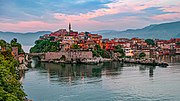political ancestors of that name: Ariobarzanes of Phrygia, who flourished 5th century BC, Ariobarzanes II of Cius, who flourished 4th century BC, and...
7 KB (679 words) - 20:19, 4 May 2024
Mount Cytorus. Its tyrant Eumenes presented the city of Amastris to Ariobarzanes of Pontus in c. 265–260 BC rather than submit it to domination by Heraclea...
17 KB (1,813 words) - 09:29, 21 March 2024
Athenian forces led by Conon in 393, and the city came under the control of Ariobarzanes, Satrap of Phrygia. In 365, an attack on Sestos by Cotys I, King of Thrace...
15 KB (1,626 words) - 10:58, 12 February 2024
the succession. Ariobarzanes II married Athenais Philostorgos II, daughter of Mithridates VI and was succeeded by his son Ariobarzanes III (51–c.42 BC)...
156 KB (20,602 words) - 21:36, 31 May 2024
Pontic Greeks (category CS1 German-language sources (de))
of Pontus, whose ancestry line dated back to Ariobarzanes I, a Persian ruler of the Greek town of Cius. The most prominent descendant of Mithridates I...
116 KB (11,854 words) - 17:31, 31 May 2024
During the Great Satraps' Revolt, Ariobarzanes, satrap of Hellespontine Phygia, joined the revolt against Artaxerxes II in 367 BC. Autophradates, satrap...
26 KB (3,128 words) - 00:40, 19 May 2024






